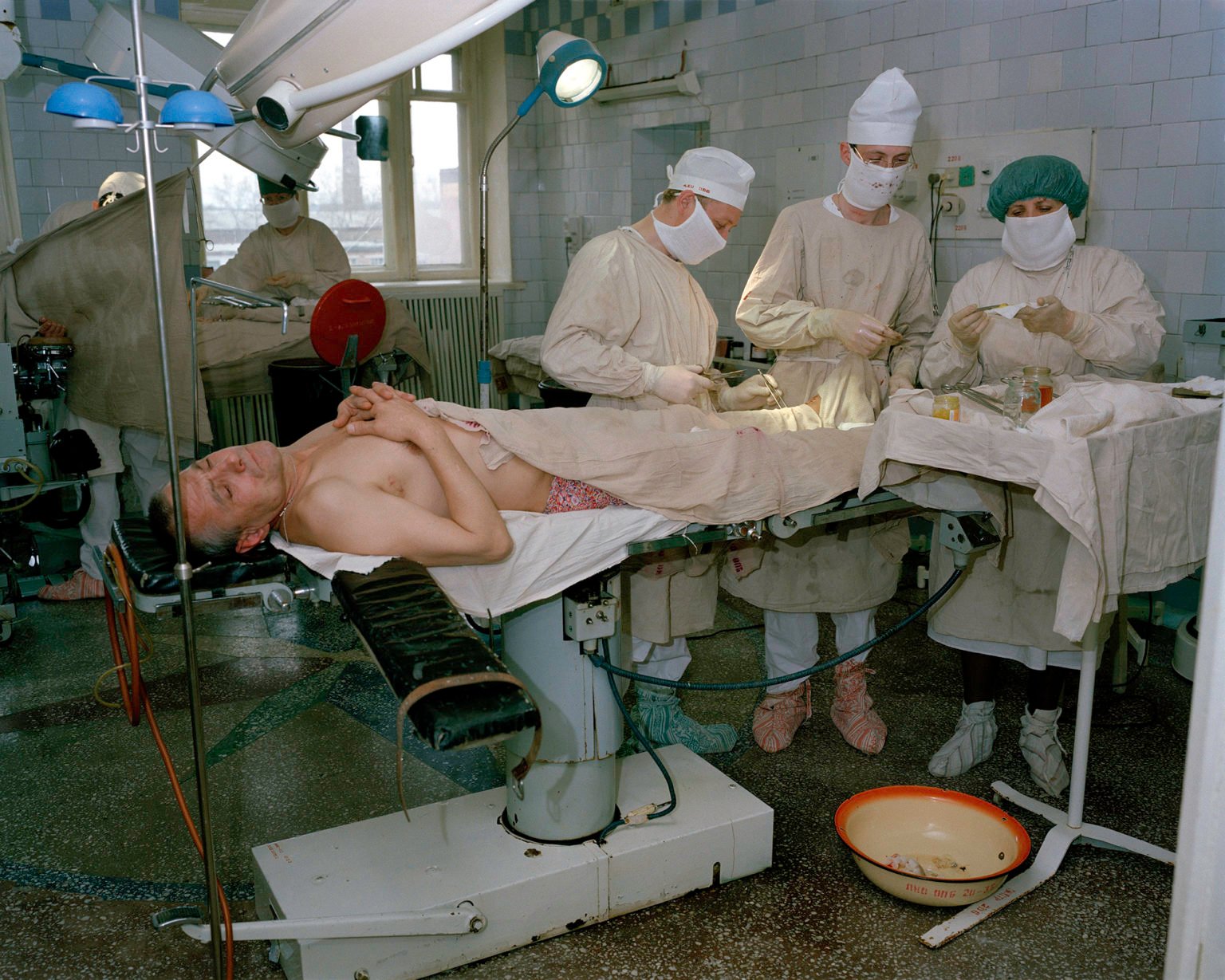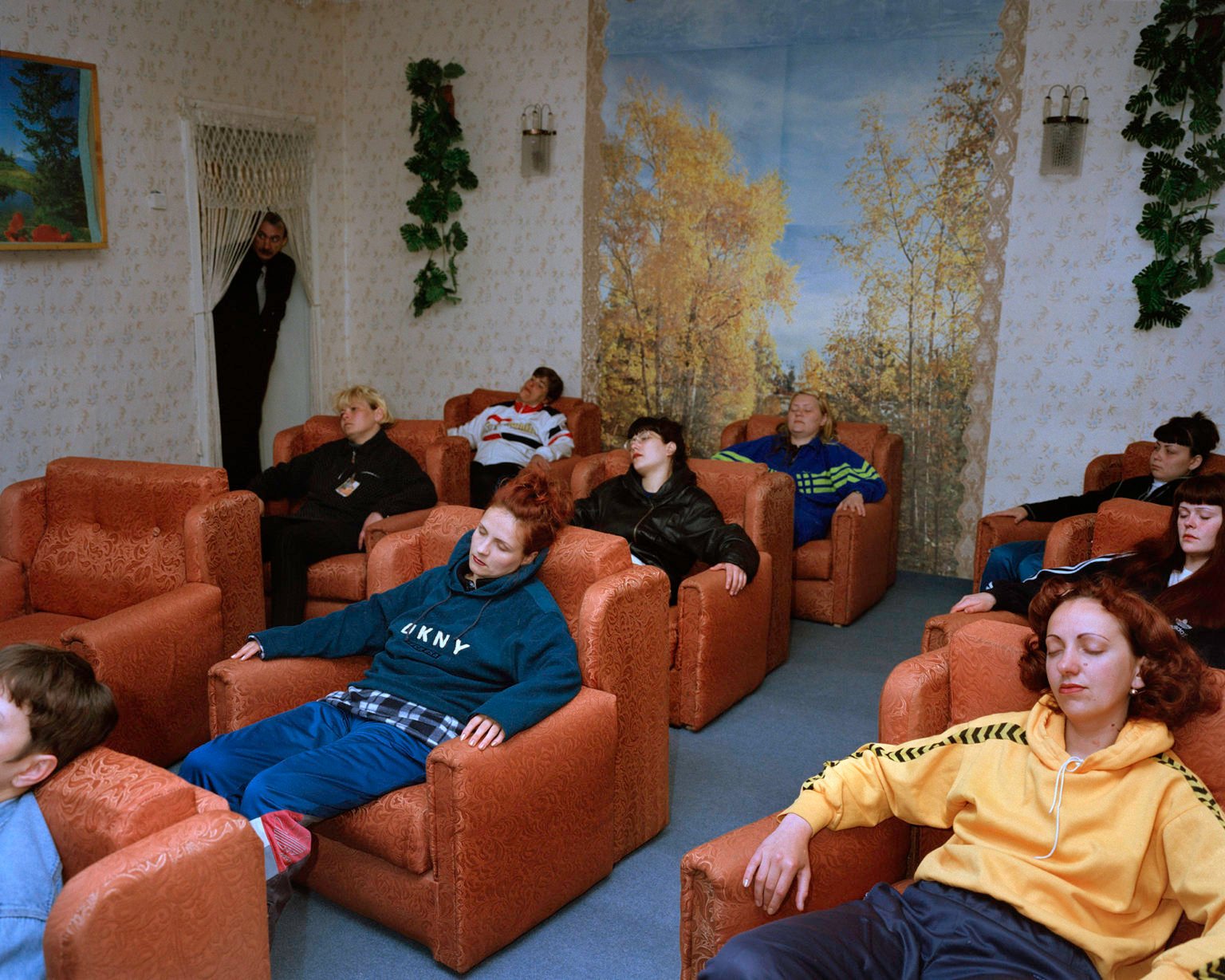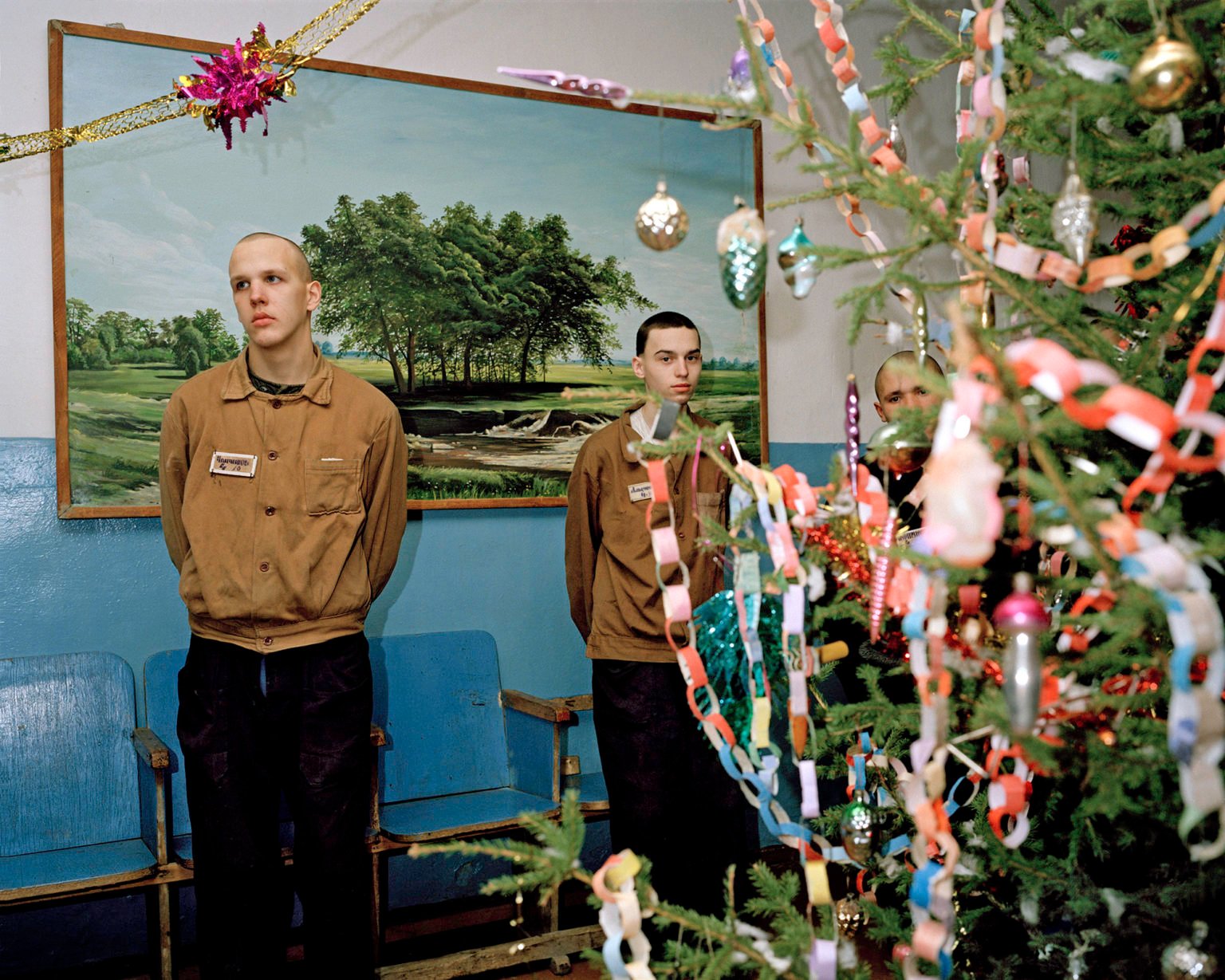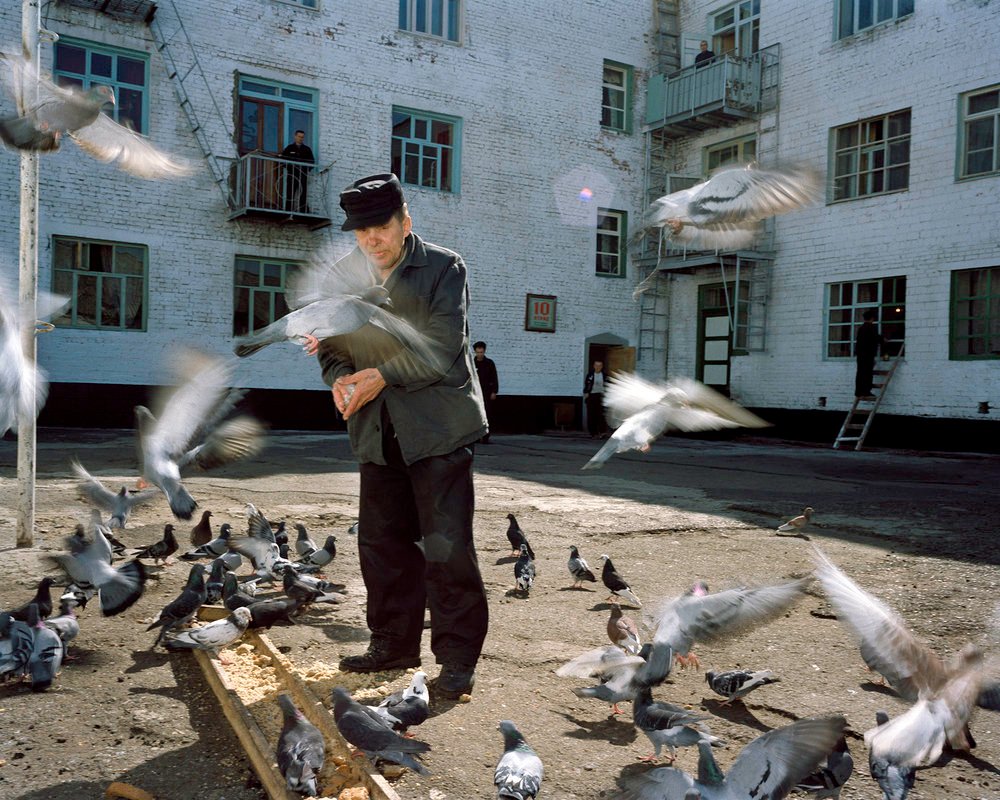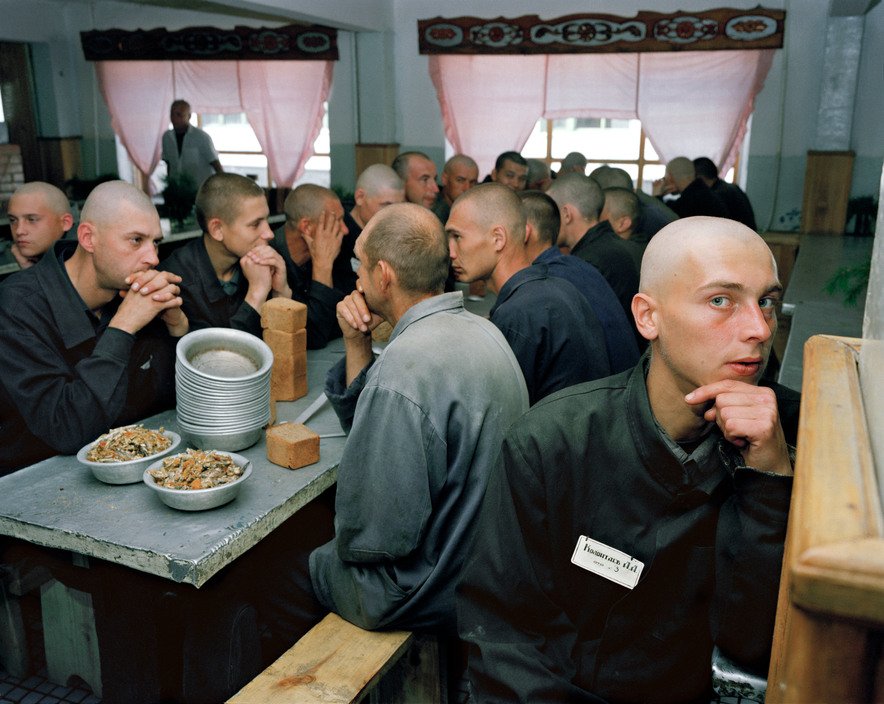Much of Carl De Keyzer’s work involves itself in the places that most will never see. His projects are not explorations: unlike most photographers most base instinct, they involve being guided, and restricted with the images that can be made. Becoming a freelance photographer in the 80s, De Keyzer’s work has always been highly aesthetic – the high contrast black and white of his earlier work, right through to the wash of colour which then followed. In the most part, his projects are an abstract telling of places – they do not attach themselves to one narrative, instead they bring together moments of spectacle, portraying a community.
With heavy cotton jackets and shaven heads, the characters wouldn’t look too out of place in Brixton, or any of the UK’s art schools. The mural covered walls, and the brightly coloured gaudy furniture could be mistaken for holiday seaside resorts. But these are images from another world – Russian prison camps (formerly known as gulags) dotted out in the rural countryside of the East, near Krasnoyarsk. Shot in the first two years of the millennia across visits to forty plus different camps (of the 130 in the area) the project encompasses, each camp containing roughly 1500 to 2500 inmates. They are bright and colourful, non-conformant to the usual images of prisons as we imagine them. There is a distinct absence of high watchtowers and impossible walls, instead replaced by green space, only a handful of fences, and even a river for inmates to bathe in. Inside, instead of the grey walls and barred windows, a colourful non-uniformity penetrates. Here, the inmates look like individuals. Camps come across more like small towns with a well established community rather than a disparate and desperate place.
It is of course, a media opportunity, directed by the state. As he says in a Magnum interview, manipulation of what he saw, and what was photographed was rife, ‘because I was there to correct all the images of the old prison system’. Despite these camps being the direct descendants of the gulags (which went out of commission after Stalin’s death in ’53), they still function. So little has ever been known about the Gulag’s that unlike other labour (or concentration, however you would like to phrase it) camps, there has been the ability for them to evolve to have instead an acceptable face. As this is a state sponsored expedition, the narrative is never allowed to develop into individual stories – they are simply prisoners – within this series they are nameless, and to all extents and purposes, presented as without cares or worries. The manipulation of the images is to present these places as this holiday camp – not an easy ride, but a place of work and discipline, rather than the grey hopelessness that prison usually offers. Now, however, all access has been rescinded – De Keyzer got lucky in the power vacuum between 1994 and 2004 – before and since, nobody else has managed to gain access.
At first glance, the state dictated narrative is effective in creating this strange utopia, but this effectiveness is only superficial. It’s important to remember when the project was being shot – in the millennia, the image was still (just about) physical. It was malleable, and controlled by those that governed. In roughly the same time, torture and abuses were being recorded in Iraq, committed by soldiers from the West, to come to light later. In effect, those in power had the same response as a child who had snuck into the sweets draw and cleaned it out. They are not sorry for what they have done, but they are sorry that they managed to be caught. We were on the precipice of a massive change – the image was no longer taken at face value. In Zona, the cracks are beginning to appear: paint is clogged, fresh and still thick on many of the walls and railings to be ready for the photographers visit; in one image prisoners stand inches away from the many landscape paintings of a small prison gallery wall. Too close to view them properly, but the right distance to be able to fit more people into the shot. In one image a pair of inmates play on the tennis court, but guards could not find a ball, so instead they mimic a game for the camera. Whilst in the library, prisoners read, but hold the books upside down. The real giveaway though, and by far the most haunting, is that dead eye, vacant stare that the few prisoners who look into the camera possess. At no point do we ever find out more about them – even in interviews, information is focused on the geography, the way in which the visits were conducted, or the behaviour of the guards. Their disinterest in the camera shows it for what it was – another visit in which they were to look the part. Knowing that both they and the photographer are being manipulated to create this curated, media friendly depiction of the camps, and through their body language the photographer is almost a state accomplice.
After only a few visits, it was quickly realised that in order to get the images they really wanted a game would have to be played. Whenever an image was taken that was deemed unsatisfactory, they would promptly be removed from the camp. A process was devised: follow the agenda, but return for that one image, and subsequently be removed because of it. In the few images which did get through there are no scenes of torture, prisoners with illness or true brutality; the visits would always be kept far enough away – the banality which can be seen is almost more horrifying. Rather than being only drawn to what is in the frame; what might be outside the frame is in every picture. This is the power of the series – outwardly, to the guards, or the state, the images are not of the grey hopelessness and the usual prison environment; to others, it is the very obvious machinations of a propaganda machine, but in which the parts are laid bare. Colour was an abrupt and important choice – it reminds people that this was shot in 2001, and that this is was a very current way of life for many thousands of people, and still may be. A momentary nature through many of these images rebuffs this – the flash and a slightly off angle emphasise this other reality in a context which is so recognisable as our own: the impact photo, taken to capture a feeling in time rather than for an aesthetic cause.
The same vacant stare always returns, throughout the series. As much as the characters are there, it is a documentation of a place, and not so much the people. They simply inhibit the place. In that vacant stare, they are statistical. That vacant stare is because they will never see the images they are in, and they have no control over their image at this point. Prisoners become not much more than numbers (the Russian penal system has the second highest prisoners per capita in the world), but because the people in these images become not much more than features of prints for sale. Despite the intimacy of the project, they are still reduced to being the faceless statistic – it calls into question the role of the photographer as being an observer, and ownership of an image between the subject and the maker.
